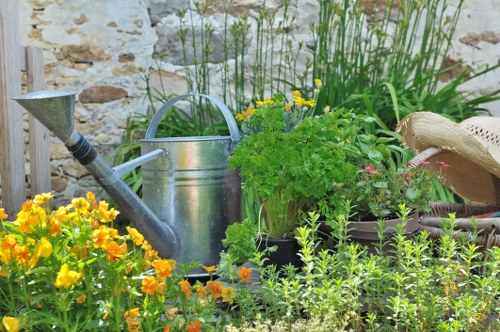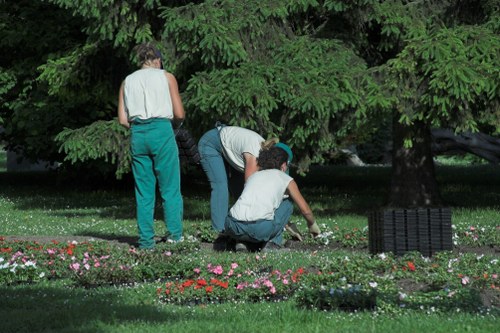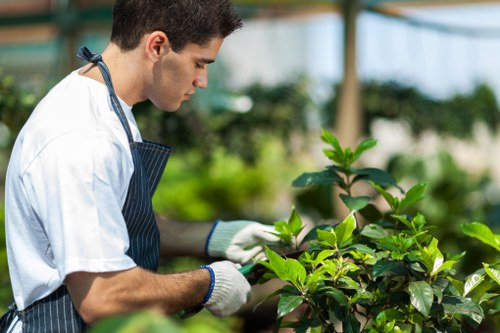Transforming Hampstead: The Art of Landscape Gardening
Introduction to Landscape Gardening in Hampstead

Hampstead, renowned for its picturesque streets and historic charm, offers a unique canvas for landscape gardening. The area's rich history and diverse plant life provide ample opportunities for creating stunning outdoor spaces. Whether you're a seasoned gardener or a novice, understanding the nuances of landscape gardening in Hampstead can help you design a garden that complements the local aesthetic while providing a personal sanctuary.
Landscape gardening goes beyond mere planting; it involves the thoughtful arrangement of flora, hardscaping elements, and sustainable practices to create a harmonious environment. In Hampstead, where space can be limited, optimizing every inch of your garden is essential. This article delves into the key aspects of landscape gardening in Hampstead, offering insights and tips to help you cultivate a beautiful and functional outdoor space.
From selecting the right plants that thrive in Hampstead's climate to incorporating sustainable gardening practices, this guide covers all you need to know to transform your garden into a verdant retreat. Whether you're aiming for a traditional English garden or a modern minimalist design, landscape gardening in Hampstead provides endless possibilities.
Understanding Hampstead's Climate and Soil

The foundation of successful landscape gardening lies in understanding the local climate and soil conditions. Hampstead enjoys a temperate maritime climate, characterized by mild winters and warm summers. This climate is conducive to a wide variety of plants, from hardy perennials to delicate annuals. However, microclimates within Hampstead can vary, influenced by factors such as proximity to Heath Park and the River Brent.
The soil in Hampstead is predominantly clay-based, which retains moisture but can be prone to compaction. To ensure healthy plant growth, it's crucial to amend the soil with organic matter like compost or well-rotted manure. This not only improves soil structure but also enhances drainage and nutrient availability. Conducting a soil test can provide valuable insights into pH levels and nutrient content, allowing you to tailor your soil amendments accordingly.
Additionally, understanding the sun exposure in different parts of your garden will help in selecting appropriate plants. Hampstead's gardens can range from shaded areas near mature trees to sunlit terraces, each requiring different plant species and care routines. By aligning your plant choices with the specific conditions of your garden, you can create a thriving landscape that flourishes year-round.
Choosing the Right Plants for Hampstead Gardens

Selecting the right plants is pivotal in landscape gardening. Hampstead's diverse climate supports a variety of plant species, but choosing those that thrive locally will ensure a resilient and vibrant garden. Native plants are an excellent choice as they are adapted to the local environment, requiring less maintenance and water.
Perennials and Annuals
Perennials, such as lavender, hostas, and peonies, provide long-lasting beauty and require minimal replanting. They are ideal for creating a stable structure in your garden. Annuals like marigolds, petunias, and geraniums, on the other hand, offer seasonal color and flexibility, allowing you to change your garden's appearance throughout the year.
Trees and Shrubs
Trees and shrubs add depth and structure to your landscape. In Hampstead, consider planting species like the Japanese maple, boxwood, or rhododendron, which not only enhance the aesthetic appeal but also provide shade and privacy. When selecting trees, consider their mature size and growth rate to ensure they fit well within your garden space.
- Native Hedgerows: Incorporate native hedgerows to create natural boundaries and habitats for local wildlife.
- Seasonal Blooms: Choose plants that offer blooms in different seasons to maintain year-round interest.
- Drought-Resistant Plants: Select drought-resistant varieties to promote sustainability and reduce water usage.
By thoughtfully selecting a mix of perennials, annuals, trees, and shrubs, you can craft a diverse and resilient garden that thrives in Hampstead's unique environment.
Design Principles for Effective Landscape Gardening

Effective landscape gardening in Hampstead involves adhering to key design principles that ensure functionality, aesthetics, and sustainability. These principles guide the arrangement of garden elements, creating a cohesive and harmonious outdoor space.
Balance and Proportion
Achieving balance involves distributing visual weight evenly across the garden. This can be symmetrical, where elements are mirrored on either side of a central axis, or asymmetrical, where different elements are balanced through color, texture, and size. Proportion relates to the size relationship between different garden elements, ensuring that no single component overwhelms the rest.
Unity and Harmony
Unity is about creating a sense of oneness in the garden, where all elements work together seamlessly. Harmony enhances this by ensuring that colors, textures, and forms complement each other, resulting in a pleasing overall effect. Consistent themes, such as cottage-style or modern minimalist, can help achieve unity and harmony in your landscape design.
Focal Points
Incorporating focal points, such as a statue, water feature, or a particularly striking plant arrangement, draws the eye and adds interest to the garden. Strategically placing these elements ensures that your garden has areas of emphasis, making the space more engaging and dynamic.
- Pathways: Create pathways to guide movement and exploration within the garden.
- Seating Areas: Designate areas for relaxation and enjoyment of your garden's beauty.
- Lighting: Use garden lighting to highlight key features and extend the usability of your outdoor space into the evening.
By applying these design principles, you can create a balanced, unified, and visually appealing garden that stands out in Hampstead's landscape.
Sustainable Gardening Practices

Sustainability is increasingly important in landscape gardening, focusing on practices that protect the environment and promote long-term garden health. In Hampstead, where green spaces are highly valued, adopting sustainable gardening methods not only benefits your garden but also the wider community.
Water Conservation
Implementing water-efficient practices is crucial, especially during dry spells. Techniques such as mulching, rainwater harvesting, and using drip irrigation systems can significantly reduce water usage. Selecting drought-resistant plants and grouping plants with similar water needs together also enhances water efficiency.
Organic Gardening
Emphasizing organic gardening means avoiding synthetic fertilizers and pesticides. Instead, use natural alternatives to enrich the soil and protect plants. Composting kitchen and garden waste not only reduces landfill contribution but also provides valuable nutrients for your garden.
Wildlife-Friendly Gardens
Creating habitats for local wildlife supports biodiversity and maintains ecological balance. Planting native species, providing shelter through hedges and shrubs, and installing features like bird baths and insect hotels attract beneficial insects, birds, and other wildlife. This natural pest control reduces the need for chemical interventions.
- Composting: Turn organic waste into nutrient-rich compost to improve soil health.
- Natural Pest Control: Encourage predators like ladybugs and birds to manage pest populations.
- Energy-Efficient Tools: Use manual or electric tools instead of gas-powered ones to minimize emissions.
Adopting these sustainable gardening practices ensures that your Hampstead garden remains healthy, vibrant, and environmentally responsible for years to come.
Incorporating Hardscaping Elements

Hardscaping elements like pathways, patios, and garden structures play a vital role in landscape gardening by providing structure and functionality. These features enhance the aesthetic appeal while facilitating movement and usage within the garden.
Pathways and Walkways
Pathways guide visitors through the garden, connecting different areas and highlighting key features. Materials such as gravel, slate, or brick can be used to create visually appealing and durable walkways. Curved paths add a sense of exploration, while straight paths create a formal and structured look.
Patios and Seating Areas
Patios offer spaces for outdoor dining, relaxation, and socializing. Choosing the right location is essential for maximizing views and ensuring comfort. Incorporate comfortable seating, shade structures like pergolas or umbrellas, and decorative elements to make these areas inviting and functional.
Garden Structures
Structures such as pergolas, gazebos, and arbors add vertical interest and provide support for climbing plants. They also create sheltered areas that can serve as focal points or transition spaces between different sections of the garden.
- Retaining Walls: Manage slopes and create terraced garden beds.
- Fences and Gates: Define property boundaries and enhance security.
- Water Features: Incorporate ponds, fountains, or waterfalls for a soothing ambiance.
Integrating these hardscaping elements thoughtfully ensures that your Hampstead garden is both beautiful and highly functional, catering to various activities and enhancing the overall landscape design.
Maintenance Tips for a Thriving Garden

Regular maintenance is key to ensuring that your garden remains healthy and vibrant throughout the year. Consistent care prevents issues from escalating and keeps your landscape gardening efforts in Hampstead looking their best.
Pruning and Trimming
Regular pruning helps maintain the shape and health of plants. Removing dead or diseased branches promotes better air circulation and encourages new growth. For hedges and shrubs, timely trimming ensures they remain tidy and well-shaped.
Weeding and Mulching
Weeding prevents unwanted plants from competing with your garden's desired flora for nutrients and water. Mulching not only suppresses weeds but also retains soil moisture and adds organic matter as it decomposes. Use organic mulches like bark or compost to enhance soil quality.
Fertilizing and Soil Care
Periodic fertilizing replenishes essential nutrients in the soil. Choose fertilizers based on soil test results to address specific deficiencies. Incorporate organic fertilizers to promote sustainable soil health and long-term plant vigor.
- Watering: Ensure plants receive adequate water, especially during dry periods.
- Pest Management: Monitor for pests and diseases, employing eco-friendly control methods when necessary.
- Lawn Care: Mow, aerate, and fertilize lawns to keep them lush and green.
By adhering to these maintenance practices, your Hampstead garden will thrive, offering a serene and beautiful outdoor space for years to come.
Seasonal Gardening in Hampstead

Each season brings its own set of challenges and opportunities for landscape gardening in Hampstead. Adapting your gardening practices to the changing seasons ensures that your garden remains vibrant and resilient throughout the year.
Spring: Renewal and Planting
Spring is the perfect time for planting new flowers, shrubs, and trees. As the weather warms, the soil becomes more workable, allowing for effective planting and establishment. Early spring is also ideal for pruning invasive species and preparing garden beds with compost and mulch.
Summer: Growth and Maintenance
During summer, focus on maintaining moisture levels and managing pests. Regular watering, especially during dry spells, is crucial. Deadheading spent blooms encourages continuous flowering, while pruning helps manage plant size and shape.
Autumn: Preparation and Cleanup
Autumn involves preparing the garden for winter. Rake fallen leaves, clean garden beds, and plant autumn-flowering species. Mulching helps protect plant roots from freezing temperatures, and it's also a great time to plant bulbs for spring blooms.
Winter: Protection and Planning
In winter, protect sensitive plants from frost by covering them with frost cloths or relocating potted plants indoors. Use this time to plan your garden layout for the upcoming year, researching new plant varieties and design ideas.
- Spring: Planting, pruning, soil preparation.
- Summer: Watering, pest control, deadheading.
- Autumn: Leaf cleanup, mulching, bulb planting.
- Winter: Protection, planning, tool maintenance.
By aligning your gardening activities with the seasons, you can ensure that your Hampstead garden remains healthy, attractive, and productive throughout the year.
Leveraging Local Expertise

While DIY gardening can be rewarding, leveraging local expertise can significantly enhance your landscape gardening efforts in Hampstead. Professional gardeners and landscape designers bring a wealth of knowledge about local plant species, soil conditions, and design trends.
Consulting with Local Gardeners
Local gardeners are familiar with Hampstead's specific challenges and can offer tailored advice. From choosing the right plants to effective pest management strategies, their insights can save you time and effort, ensuring your garden thrives.
Hiring Professional Landscape Designers
Professional landscape designers can transform your vision into reality, providing creative design solutions that maximize your garden's potential. They can handle everything from initial planning and plant selection to the installation of hardscaping elements and irrigation systems.
Utilizing Community Resources
Engaging with local gardening clubs, attending workshops, and participating in community gardens can provide additional support and inspiration. These resources offer opportunities to learn from others, share experiences, and stay updated on the latest gardening practices.
- Workshops: Attend gardening workshops to learn new techniques and trends.
- Garden Tours: Participate in local garden tours for inspiration and ideas.
- Online Forums: Join online communities to seek advice and share your gardening journey.
By tapping into local expertise and community resources, you can enhance your landscape gardening endeavors in Hampstead, ensuring a beautiful and sustainable garden that reflects your personal style.
Innovative Garden Features

Incorporating innovative features into your Hampstead garden can elevate its aesthetic and functionality. From modern water features to smart irrigation systems, these additions can make your garden more enjoyable and sustainable.
Water Features
Water features like ponds, fountains, and waterfalls add a soothing element to your garden, attracting wildlife and creating a tranquil atmosphere. They can serve as focal points and contribute to the overall soundscape, masking urban noise and enhancing relaxation.
Outdoor Lighting
Strategic outdoor lighting extends the usability of your garden into the evening hours. Solar-powered lights, LED fixtures, and pathway lights not only improve safety but also highlight key garden features, creating a magical ambiance after dark.
Smart Irrigation Systems
Smart irrigation systems use technology to optimize water usage, adjusting watering schedules based on weather conditions and soil moisture levels. These systems ensure that your plants receive the right amount of water, promoting healthy growth while conserving resources.
- Vertical Gardens: Maximize space and add greenery to walls and fences.
- Outdoor Kitchens: Create functional spaces for cooking and entertaining.
- Fire Pits: Provide warmth and a focal point for gatherings.
Incorporating these innovative features can enhance the beauty and functionality of your Hampstead garden, making it a versatile and inviting outdoor space.
Final Thoughts on Landscape Gardening in Hampstead
Landscape gardening in Hampstead is an art that blends creativity, sustainability, and practicality. By understanding the local climate and soil, selecting the right plants, adhering to design principles, and incorporating sustainable practices, you can create a garden that not only enhances your property but also contributes to the beauty of the community.
Embrace the unique opportunities that Hampstead offers, from its diverse plant life to its historic charm, to cultivate a garden that reflects your personal style and meets your practical needs. Whether you're looking to create a serene retreat, a vibrant floral display, or a functional outdoor living space, effective landscape gardening can help you achieve your goals.
Don't hesitate to reach out to local gardening experts or join community gardening groups to expand your knowledge and gain inspiration. With dedication and thoughtful planning, your Hampstead garden can become a stunning showcase of landscape gardening excellence.
Contact us today to begin your journey toward creating the garden of your dreams in Hampstead!